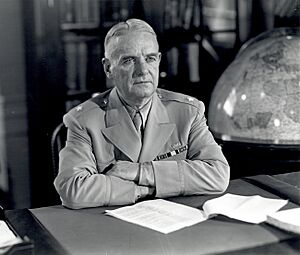Office of Strategic Services facts for kids
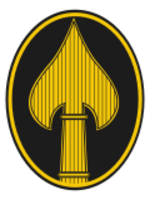
OSS insignia
|
|
| Agency overview | |
|---|---|
| Formed | June 13, 1942 |
| Preceding agency |
|
| Dissolved | September 20, 1945 |
| Superseding agencies |
|
| Employees | 13,000 estimated |
| Agency executives |
|
The Office of Strategic Services (OSS) was a special intelligence agency of the United States during World War II. It was created to gather secret information and carry out special missions behind enemy lines. The OSS also used propaganda (spreading information to influence people) and worked to weaken enemy forces.
The OSS was part of the Joint Chiefs of Staff, a group of top military leaders. After World War II ended, the OSS was closed down. Its important tasks were later taken over by new organizations. These included the Department of State's Bureau of Intelligence and Research and the Central Intelligence Agency (CIA). In 2016, the OSS was given the Congressional Gold Medal for its service.
Contents
How the OSS Started
Before the OSS, different parts of the U.S. government gathered information on their own. There was no single group in charge of all American intelligence. For example, the Army and Navy had their own secret code-breaking teams. An earlier State Department code-breaking group was even shut down because it was seen as improper. The FBI handled security and anti-spy operations inside the U.S.
President Franklin D. Roosevelt was worried that American intelligence wasn't strong enough. A British intelligence officer, William Stephenson, suggested creating a new spy service. Roosevelt asked William J. Donovan to plan this new agency. Donovan wanted one agency to handle foreign intelligence and special operations. This included commandos (special soldiers), spreading false information, and supporting resistance fighters.
Donovan worked closely with Charles Howard 'Dick' Ellis, a British intelligence officer. Ellis helped write the plan for the new American agency. He said he was asked to create a "blueprint" for an American intelligence agency, similar to British groups.
After presenting his plan, Donovan became the "Coordinator of Information" (COI) in July 1941. This was the first step towards the OSS. Ellis was described as Donovan's "right-hand man" and helped run the organization.
At first, the COI had responsibilities but little real power. Other U.S. agencies were unsure about working with the British. Much of the early intelligence came from the United Kingdom. British groups trained the first OSS agents in Canada. They also shared information on how their own special operations were organized. The British even provided equipment and radio broadcasting help until the U.S. could produce its own.
William J. Casey, who later became director of the CIA, wrote that Ellis helped set up training centers. An Assistant Secretary of State even commented that Ellis was "running Donovan's intelligence service."
President Roosevelt officially created the Office of Strategic Services on June 13, 1942. Its job was to collect and study important information for the Joint Chiefs of Staff. It also carried out special missions that other agencies didn't handle. However, the OSS didn't control all foreign intelligence. The FBI still handled work in Latin America, and the Army and Navy kept their own intelligence sources.
What the OSS Did
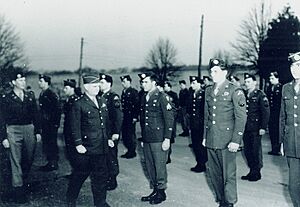

The OSS was very helpful in understanding Germany's war efforts. In direct operations, it helped Operation Torch in North Africa in 1942. There, it found people who supported the Allies and located good landing spots. OSS operations in neutral countries like Sweden gathered detailed information on German technology. The OSS station in Madrid created spy networks in France. These networks helped the Allied invasion of southern France in 1944.
Some of the most famous operations were in Switzerland, led by Allen Dulles. These provided a lot of information about German military strength, air defenses, and V-1 and V-2 weapons. The OSS even uncovered some German secret efforts in chemical and biological warfare. The Switzerland station also supported resistance fighters in France, Austria, and Italy. It helped with the surrender of German forces in Italy in 1945.
During World War II, the OSS did many things. This included collecting intelligence (spying), performing sabotage (damaging enemy property), and waging propaganda war. They also organized anti-Nazi resistance groups in Europe. In Asia, they trained anti-Japanese guerrilla movements. At its peak, the OSS had almost 24,000 employees.
From 1943 to 1945, the OSS trained Chinese and Burmese troops. They also recruited local forces for sabotage and to guide Allied troops in Burma. The OSS helped arm and train resistance movements in areas controlled by the Axis powers. This included Mao Zedong's Red Army in China and the Viet Minh in French Indochina.
One of the OSS's biggest achievements was sending agents into Nazi Germany. The OSS trained German and Austrian people for these missions. These agents included exiled communists, labor activists, and German and Jewish refugees. The OSS also recruited a very important spy, the German diplomat Fritz Kolbe.
The OSS was in contact with an Austrian resistance group led by Kaplan Heinrich Maier. This group shared plans and details about German weapons factories. This allowed Allied bombers to make accurate air strikes. The group also gave early warnings about the mass murder of Jews.
In 1943, the OSS started operations in Istanbul, Turkey. Turkey was a neutral country during the war, making it a hub for spies from both sides. The head of OSS operations there was Lanning "Packy" Macfarland. He hired Alfred Schwarz, an Austrian businessman known as "Dogwood." Through Schwarz, the OSS was able to get information from anti-fascist groups in Austria, Hungary, and Germany. Couriers smuggled intelligence by memorizing it or hiding microfilms in their shoes.
However, British intelligence began to question the reliability of the "Dogwood-chain." By May 1944, it was found to be unreliable and dangerous. Some information was fake, meant to mislead the Allies. The Dogwood-chain, which was the largest American intelligence network in occupied territory, was soon shut down.
The OSS also bought Soviet code materials from Finnish officers in late 1944. This material was later used in the Venona decryption effort. This effort helped uncover large-scale Soviet spying in North America.
"RYPE" was the code name for an airborne unit dropped into the Norwegian mountains in March 1945. Their mission was to sabotage railroads to stop German forces from leaving northern Norway. This was the only U.S. operation on German-occupied Norwegian soil during WW2. The group was led by William Colby.
Cool Weapons and Gadgets
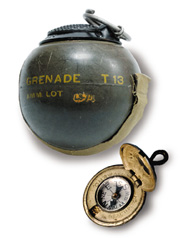
The OSS needed very special equipment for its spy and sabotage missions. General Donovan brought in experts and funded labs to create these tools. This became the Research & Development Branch. Its first head was Stanley P. Lovell, whom Donovan jokingly called his "Professor Moriarty" (a famous villain).
During the war, the OSS Research & Development team made many new spy tools. These included silenced pistols and lightweight machine guns. They also made "Beano" grenades that exploded on impact. Other clever items were explosives disguised as lumps of coal ("Black Joe") or bags of flour ("Aunt Jemima"). They also created compasses hidden in uniform buttons and playing cards that hid maps. There was even a tiny 16mm Kodak camera shaped like a matchbox. For secret operations, they had tasteless poison tablets and cigarettes that made people talk a lot.
The OSS also developed advanced communication tools. These included wiretap gadgets and electronic beacons to locate agents. The ""Joan-Eleanor" portable radio system allowed agents on the ground to talk securely with planes. The Research & Development team also printed fake German and Japanese ID cards, passes, and counterfeit money.
In 1943, Stanley Lovell gave a presentation to military leaders who doubted the OSS. To show off his department's purpose, he reportedly dropped a "Hedy" into a waste basket. The Hedy was a small explosive device that made a loud shrieking sound followed by a huge boom. Everyone in the room fled! The Hedy, jokingly named after Hollywood star Hedy Lamarr, later saved the lives of some trapped OSS agents.
Not all projects worked out. Some ideas were unusual, like trying to use insects to spread disease. Stanley Lovell once said, "It was my policy to consider any method whatever that might aid the war, however unorthodox or untried."
In 1939, a young doctor named Christian J. Lambertsen invented an oxygen rebreather (a device for breathing underwater). He showed it to the OSS in 1942. The OSS loved the idea and hired Lambertsen to lead a program. He trained divers and developed ways to combine diving with swimmer delivery for the OSS "Operational Swimmer Group." This led to the creation of the OSS Maritime Unit, which focused on coastal infiltration and water-based sabotage.
Training Facilities
The OSS set up many training camps. One famous one was Camp X in Canada, run by the British. It was called "the school of mayhem and murder" because it taught intense combat skills, including knife fighting. Many OSS members trained there.
In the U.S., the OSS used land from the National Park Service for training. Prince William Forest Park was used for communications training. Catoctin Mountain Park, now home to Camp David, was where the first Special Operations (SO) agents trained. SO training included parachuting, sabotage, self-defense, and weapons use. This prepared agents to support resistance groups.
The "Secret Intelligence" (SI) branch, which handled spying, used country estates as schools. These were places like "the Farm" where recruits learned about espionage. The Congressional Country Club in Bethesda, Maryland, was a main OSS training facility. There was also a survival training camp on Santa Catalina Island in California.
Overseas, the OSS had training camps in Great Britain, French Algeria, and Egypt. As the Allies advanced, a school was set up in southern Italy. In Asia, facilities were in India, Ceylon, and China. The London branch was the first overseas OSS facility. These overseas schools provided advanced training for agents from the U.S. and for Americans who joined the OSS in war zones, like Virginia Hall in France.
The OSS's Mediterranean training center in Cairo, Egypt, was known as the Spy School. It was a grand palace. People of Italian, Yugoslavian, and Greek heritage were trained there. They learned parachuting, weapons, commando skills, and Morse code. After training, these agents were sent back to their home regions for missions, where their accents would not give them away.
Key People in the OSS
The names of all 13,000 OSS personnel were kept secret for a long time. But in 2008, the U.S. National Archives released them. Among the famous people who served in the OSS were:
- Julia Child, who later became a famous cookbook author.
- Moe Berg, a major league baseball player and polyglot (someone who speaks many languages). He was sent to find information on German physicist Werner Heisenberg and his knowledge of the atomic bomb.
- Colonel Peter Ortiz, a highly decorated U.S. Marine who joined the French Foreign Legion before the OSS.
- René Joyeuse, a doctor and soldier who received a high award for his actions in German-occupied France.
- "Jumping Joe" Savoldi, a former football player known for his combat and language skills. He helped infiltrate the black market in Naples.
- Jack Taylor, a Navy Lieutenant who had a long career behind enemy lines.
- Taro Yashima and Mitsu Yashima, Japanese political activists who worked against the Japanese Empire.
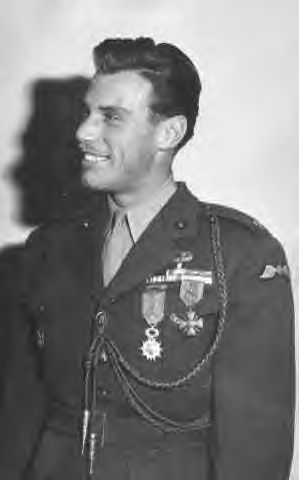
Most OSS soldiers came from the United States Armed Forces. But the OSS also recruited people from other countries. Donovan looked for independent thinkers from all backgrounds. He famously said, "I'd rather have a young lieutenant with enough guts to disobey a direct order than a colonel too regimented to think for himself."
Nisei Linguists In late 1943, the OSS looked for Japanese American volunteers from the 442nd Infantry Regiment. These "Nisei" (second-generation Japanese Americans) were assigned to special OSS groups in China, Burma, and India. Their jobs included questioning prisoners, translating documents, and monitoring radio communications. Their secret operations were very successful.
What Happened After the OSS?
On September 20, 1945, President Truman signed an order to close down the OSS. The Research and Analysis Branch (R&A) went to the State Department, becoming the Bureau of Intelligence and Research. The Secret Intelligence (SI) and Counter-Espionage (X-2) Branches went to the War Department, forming the new Strategic Services Unit (SSU).
In January 1946, President Truman created the Central Intelligence Group (CIG). This was the direct ancestor of the CIA. The SSU's secret intelligence capabilities were moved to the CIG. In 1947, the National Security Act of 1947 officially created the Central Intelligence Agency (CIA), which took over some of the OSS's original jobs. The CIA's Special Activities Division continues some of the paramilitary work of the OSS today.
Today, the United States Special Operations Command, formed in 1987, uses a similar spearhead design on its symbol. This is to honor its connection to the OSS. The Defense Intelligence Agency now handles the OSS's original mission of providing military intelligence and coordinating human espionage for the U.S. military.
OSS Branches
- Censorship and Documents
- Field Experimental Unit
- Foreign Nationalities
- Maritime Unit (focused on water operations)
- Morale Operations (psychological warfare)
- Operational Group Command (special forces)
- Research & Analysis (studying information)
- Secret Intelligence (spying)
- Security
- Special Operations (sabotage and supporting resistance)
- Special Projects
- X-2 (stopping enemy spies)
OSS Detachments
- OSS Deer Team: Vietnam
- OSS Detachment 101: Burma
- OSS Detachment 202: China
- OSS Detachment 303: New Delhi, India
- OSS Detachment 404: attached to British forces in Kandy, Ceylon
- OSS Detachment 505: Calcutta, India
- US Army units attached to the OSS
- 2671st Special Reconnaissance Battalion
- 2677th Office of Strategic Services Regiment
See also
- Charles Douglas Jackson
- Dick Ellis
- Operation Jedburgh
- Operation Paperclip
- Paramarines
- Special Forces (United States Army)
- X-2 Counter Espionage Branch
- History of espionage
- Art Looting Investigation Unit (ALIU)
- Millard Preston Goodfellow
- William J. Donovan
- The Pond
- Garland H. Williams


